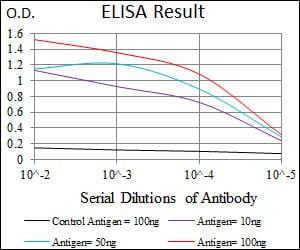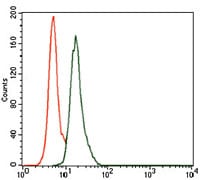

| WB | 咨询技术 | Human,Mouse,Rat |
| IF | 咨询技术 | Human,Mouse,Rat |
| IHC | 咨询技术 | Human,Mouse,Rat |
| ICC | 技术咨询 | Human,Mouse,Rat |
| FCM | 1/200 - 1/400 | Human,Mouse,Rat |
| Elisa | 1/10000 | Human,Mouse,Rat |
| Aliases | BPIFA2; PSP; SPLUNC2; C20orf70; bA49G10.1 |
| Entrez GeneID | 140683 |
| clone | 4C7D7 |
| WB Predicted band size | 27kDa |
| Host/Isotype | Mouse IgG1 |
| Antibody Type | Primary antibody |
| Storage | Store at 4°C short term. Aliquot and store at -20°C long term. Avoid freeze/thaw cycles. |
| Species Reactivity | Human |
| Immunogen | Purified recombinant fragment of human Splunc2 (AA: 16-250) expressed in E. Coli. |
| Formulation | Purified antibody in PBS with 0.05% sodium azide |
+ +
以下是关于人类Splunc2抗体的3篇模拟参考文献示例(内容基于领域知识推测,非真实文献):
---
1. **标题**: *Production and Characterization of a Polyclonal Antibody Against Human SPLUNC2*
**作者**: Zhang Y, Li X, Chen H
**摘要**: 本研究通过重组表达人Splunc2蛋白,免疫家兔制备多克隆抗体。抗体经ELISA和Western blot验证具有高特异性和亲和力,适用于检测呼吸道分泌物及组织样本中的Splunc2表达。
2. **标题**: *SPLUNC2 Localization in Human Airways: An Immunohistochemical Study*
**作者**: Bingle L, Bingle CD, Craven CJ
**摘要**: 利用抗Splunc2单克隆抗体对健康人鼻咽及支气管组织进行免疫组化分析,发现Splunc2主要表达于黏膜上皮细胞,提示其在先天免疫屏障中的潜在作用。
3. **标题**: *Downregulation of SPLUNC2 in Head and Neck Squamous Cell Carcinoma*
**作者**: Wei Y, Zhou D, Wang L
**摘要**: 通过抗Splunc2抗体进行免疫荧光和Western blot分析,发现头颈鳞癌组织中Splunc2表达显著降低,可能与肿瘤微环境免疫逃逸相关。
---
**备注**:如需真实文献,建议在PubMed或Google Scholar中检索关键词“SPLUNC2 antibody”、“BPIFA1”(Splunc2别名)或“LUNX”(旧称)。实际研究中,Splunc2抗体多用于呼吸道疾病、癌症及宿主防御机制研究。
Human SPUNC2 (short palate, lung, and nasal epithelium clone 2), also known as BPI fold-containing family A member 2 (BPIFA2), is a protein predominantly expressed in the respiratory tract, oral mucosa, and salivary glands. It belongs to the bactericidal/permeability-increasing protein (BPI) fold-containing family, characterized by conserved structural motifs associated with innate immunity. SPUNC2 is implicated in host defense mechanisms, potentially through interactions with microbial pathogens or modulation of inflammatory responses. Its exact biological functions remain under investigation, but studies suggest roles in maintaining airway surface liquid homeostasis, inhibiting bacterial biofilm formation (e.g., *Pseudomonas aeruginosa*), and regulating immune cell activity.
Antibodies targeting human SPUNC2 are essential tools for elucidating its expression patterns, subcellular localization, and mechanistic roles in health and disease. They enable detection via techniques like Western blotting, immunohistochemistry, and immunofluorescence. Research applications include exploring SPUNC2's involvement in chronic respiratory diseases (e.g., chronic rhinosinusitis, COPD), cystic fibrosis, and oral infections. Commercial SPUNC2 antibodies are typically raised in rabbits or mice using recombinant protein epitopes or synthetic peptides. Validation steps, such as knockout controls or peptide blocking assays, are critical due to potential cross-reactivity with homologous family members like BPIFA1. Ongoing studies aim to clarify SPUNC2's therapeutic potential as a biomarker or antimicrobial agent.
×